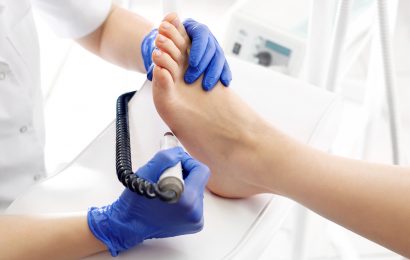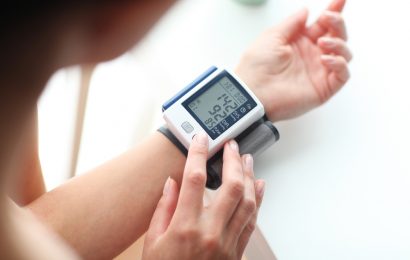When you were diagnosed with diabetes, you were most likely told about the importance of monitoring your blood glucose levels, given or prescribed a blood glucose meter, taught how to use it, and given target blood glucose goals.
But you probably weren’t told about monitoring your blood pressure at home, even though maintaining a healthy blood pressure level is an important part of preventing long-term diabetes complications. For many people, monitoring at home provides the feedback they need to reach blood pressure goals.
Multiple large studies have shown that effective diabetes management reduces the risk of diabetes complications. These studies have demonstrated that managing not just blood glucose, but also blood pressure and lipids (cholesterol and triglycerides), leads to the lowest risk of complications such as heart disease. (For information about blood glucose, blood pressure, and blood lipids targets, see “The ABCs of Diabetes.”) Some of these conditions may stem from high blood pressure and lipids even more so than from high blood glucose.
What is blood pressure?
Blood pressure is the force of blood in your arteries, the vessels that carry blood from your heart to the rest of your body. Your blood pressure is higher when your heart beats and lower when your heart is between beats. That’s why a blood pressure measurement has two parts: systolic pressure (the first number), the force during a heartbeat; and diastolic pressure (the second number), the force when the heart is at rest. Blood pressure is measured in millimeters of mercury, abbreviated “mm Hg.”
Everyone needs a certain level of blood pressure to survive, but high blood pressure (also known as hypertension) is damaging to the body. The American Diabetes Association recommends that people with diabetes maintain blood pressure below 130/80 mm Hg.
The silent killer
Two out of three people with diabetes have high blood pressure, compared with one out of three American adults generally. Having diabetes also raises the risk of future high blood pressure.
High blood pressure increases the workload on the heart to maintain the body’s necessary blood flow. Not only does it cause the heart to pump harder, it also puts greater strain on the arteries. High blood pressure often causes no symptoms, but if left untreated, it can lead to serious health problems such as stroke, congestive heart failure, heart attack, and kidney failure.
If no measures are put in place to monitor your heart health, a “cardiovascular event” such as a heart attack can seem to occur out of the blue. According to the American Heart Association, about 310,000 people die suddenly each year of coronary heart disease without ever being hospitalized or even admitted to an emergency room. Monitoring your blood pressure at home, recording the results, and showing them to your doctor at regular appointments may help to reduce your risk of sudden death, since any signs of trouble can be noted and treated early.
Call to action
In view of the lifesaving possibilities of checking blood pressure at home, the American Heart Association, the American Society for Hypertension, and the Preventive Cardiovascular Nurses Association issued a joint statement in May 2008 recommending that all people with known or suspected high blood pressure do it. The statement was published in Hypertension, a journal of the American Heart Association.
The key points in this “Call to Action” included the following:
- Home blood pressure monitoring (HBPM) overcomes many of the limitations of traditional, doctor’s office—based blood pressure measurement.
- HBPM is cheaper and easier than ambulatory blood pressure monitoring, in which a person wears a small machine that measures blood pressure every 15—30 minutes for 24 hours. Ambulatory blood pressure monitoring requires at least two visits to the health-care provider’s office: one to have the device put on, and one to return it the next day. Some health insurance plans cover the cost of ambulatory blood pressure monitoring, and some do not.
- Accurate, reliable, easy-to-use, and relatively inexpensive home blood pressure monitors are widely available. Many home monitors use the preferred oscillometric method to measure blood pressure (which uses an electronic pressure sensor), and most are fully automatic, meaning the user attaches the cuff, presses a button, and waits for the machine to do the rest. They can be cord- or battery-operated. An increasing number of people are using these monitors to regularly check their blood pressure at home.
- While HBPM has been endorsed by national and international guidelines, detailed recommendations for it have been lacking.
- There is a growing body of evidence that blood pressure readings done at home tend to be lower than those taken in a doctor’s office. The home measurements also tend to be closer to the average blood pressure recorded by 24-hour ambulatory monitors, which tends to be the best predictor of cardiovascular risk.
- A larger number of blood pressure readings can be taken by using HBPM than by measuring blood pressure only in the doctor’s office during appointments.
- White-coat hypertension, a temporary rise in blood pressure that occurs in many people during doctor’s office visits, is eliminated with home measurement.
- Scientific studies using multiple home readings have found that home blood pressure readings predict cardiovascular risk better than medical office readings.
Home monitoring recommendations
The following recommendations are based on the “Call to Action”:
1. Most people with known or suspected high blood pressure should make HBPM a routine part of blood pressure management.
2. Purchase an oscillometric monitor that measures blood pressure on the upper arm. It is of utmost importance for an accurate reading that the cuff fit your arm. If you are significantly under- or overweight, you may need to purchase a cuff that fits your arm separately from the monitor.
Check the cuff size when you purchase your monitor. If you’re unsure whether it will fit, ask your pharmacist, the retailer selling the monitor, or the manufacturer. You can special-order cuffs for some monitors.
3. While resting in a seated position, take two to three readings in a row, then average the numbers you get from these readings (some monitors will do this for you). Do this every day for a week, both in the morning and at night. Your health-care provider will need at least 12 readings to make any decisions about your care.
4. HBPM is recommended for people with newly diagnosed high blood pressure. It is also recommended if high blood pressure is suspected – that is, if home monitoring may help to distinguish between white-coat hypertension and sustained high blood pressure. If the results are equal, ambulatory blood pressure monitoring can be used to find out whether blood pressure is consistently high.
5. In people with prehypertension (blood pressure between 120/80 mm Hg and 139/89 mm Hg), HBPM may be useful to detect masked hypertension, in which blood pressure is lower in the doctor’s office than at other times.
6. HBPM should be used to evaluate the response to any blood-pressure-lowering treatment. HBPM may help you adhere to your treatment, since you are more actively involved.
7. The target HBPM goal for most people is below 135/85 mm Hg. It is below 140/80 mm Hg for people with diabetes. (For tips on lowering blood pressure, click here.)
8. HBPM is useful for elderly people because of the increased variability in blood pressure that comes with age, and because older individuals have a higher incidence of white-coat hypertension.
9. HBPM is valuable for people with diabetes, in whom blood pressure control is of paramount importance for prevention of diabetes-related complications.
10. HBPM is valuable in other populations such as pregnant women and people with kidney disease.
11. HBPM has the potential to improve quality of care while reducing costs and should therefore be reimbursed by health insurance providers. Home blood pressure monitors typically cost between $50 and $120. Some insurance companies will reimburse you for a blood pressure monitor; many will not. If you have insurance, ask before purchasing one. You may need to get a prescription or complete other paperwork. If your insurance doesn’t cover a home blood pressure monitor, buy one yourself if at all possible.
Getting an accurate reading
How you go about taking your blood pressure at home matters; you must do it right to get an accurate reading:
- Purchase and use an accurate oscillometric blood pressure monitor. (Your doctor, diabetes educator, or pharmacist should be able to help you select an accurate monitor.)
- Monitor your blood pressure within an hour of waking up and at bedtime, or when recommended by your health-care provider.
- Make sure the cuff is the correct size for your arm. (See “Finding Your Cuff Size.”)
- Apply the cuff correctly, following the manufacturer’s instructions.
- Remove all clothing from the arm you will be using.
- Avoid eating, drinking alcohol or caffeine, using tobacco, exercising, or bathing for at least 30 minutes before taking a measurement.
- Rest for at least 5 minutes before taking your blood pressure.
- When taking a measurement, sit in a straight-backed chair with your feet uncrossed, flat on the floor.
- Keep your arm at heart level, resting your forearm on a table.
- Do not talk during blood pressure monitoring.
- Take two to three readings, waiting at least one minute between readings, then average the three. Most automatic blood pressure monitors will do this for you.
- Record your readings, either by hand or electronically. Make sure to include the date and time. (Some home monitors come with software that lets you upload stored readings to your computer using a cable.)
- Write down any information that may be relevant to your blood pressure, such as when you took your medicine, whether you missed your medicine, whether you have a headache or feel light-headed, or whether you feel great.
- Bring your numbers with you when you visit your health-care provider, and find out if there is a particular time when you should call your numbers in between visits.
Make it automatic
It may seem like monitoring both your blood glucose and your blood pressure is a lot to do, and it is. But you can make it easier by keeping your supplies together and doing both measurements at the same time. It may help to designate a particular place to keep your monitoring equipment, such as by your computer or at your kitchen table. When you wake up in the morning, go to the bathroom and wash your hands, then sit down, relax for a few minutes (maybe while watching TV, checking your e-mail, or reading), and check your blood glucose and blood pressure. Taking care of your diabetes is a great way to start your day!




